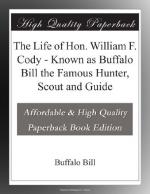Acting upon my suggestions, Fitzhugh, Crosby, Lawrence Jerome, Livingston, Hecksher and Rogers, accompanied by myself as guide, rode through a convenient canon to a point beyond the buffaloes, so that we were to the windward of the animals. The rest of the party made a detour of nearly five miles, keeping behind the crest of a hill. We charged down upon the buffaloes, at full gallop, and just then the other party emerged from their concealment and witnessed the exciting chase. The buffaloes started off in a line, single file. Fitzhugh, after a lively gallop, led us all and soon came alongside the rear buffalo, at which he fired. The animal faltered, and then with another shot Fitzhugh brought him to the ground. Crosby dashed by him and leveled another of the herd, while Livingston dropped a third. Those who were not directly engaged in the hunt now came up and congratulated the men upon their success, and Fitzhugh was at once hailed as the winner of the buffalo cup; while all sympathized with Hecksher, whose chance had been the best at the start, but who lost by reason of his horse falling and rolling over him.
The hunt being over, the column moved forward on its march passing through a prairie-dog town, several miles in extent. These animals are found throughout the plains, living together in a sort of society; their numberless burrows in their “towns” adjoin each other, so that great care is necessary in riding through these places, as the ground is so undermined as often to fall in under the weight of a horse. Around the entrance to their holes the ground is piled up almost a foot high; on these little elevations the prairie-dogs sit upon their hind legs, chattering to each other and observing whatever passes on the plains. They will permit a person to approach quite near, but when they have viewed him closely, they dive into their dens with wonderful quickness. They are difficult to kill, and if hit, generally succeed in crawling underground before they can be captured. Rattlesnakes and small owls are generally found in great numbers in the prairie-dog towns, and live in the same holes with the dogs on friendly terms. A few of the prairie-dogs were killed, and were found to be very palatable eating.
[Illustration: PRAIRIE-DOG VILLAGE.]
A short distance beyond the dog town we discovered a settlement of five white men, who proved to be the two Clifford brothers, Arthur Ruff, Dick Seymour and John Nelson—the latter already referred to in these pages. Each of them had a squaw wife and numerous half-breed children, living in tents of buffalo skins. They owned a herd of horses and mules and a few cattle, and had cultivated a small piece of land. Their principal occupation was hunting, and they had a large number of buffalo hides, which, they had tanned in the Indian manner.
Upon reaching Pleasant Valley, on Medicine Creek, our party divided into two detachments—one hunting along the bank of the stream for elk or deer, and the other remaining with the main body of the escort. The elk hunters met with no success whatever, but the others ran across plenty of buffaloes, and nearly everybody killed one or more before the day was over. Lawrence Jerome made an excellent shot; while riding in an ambulance he killed a buffalo which attempted to cross the line of march.




